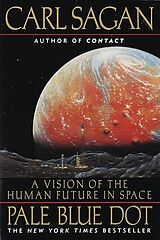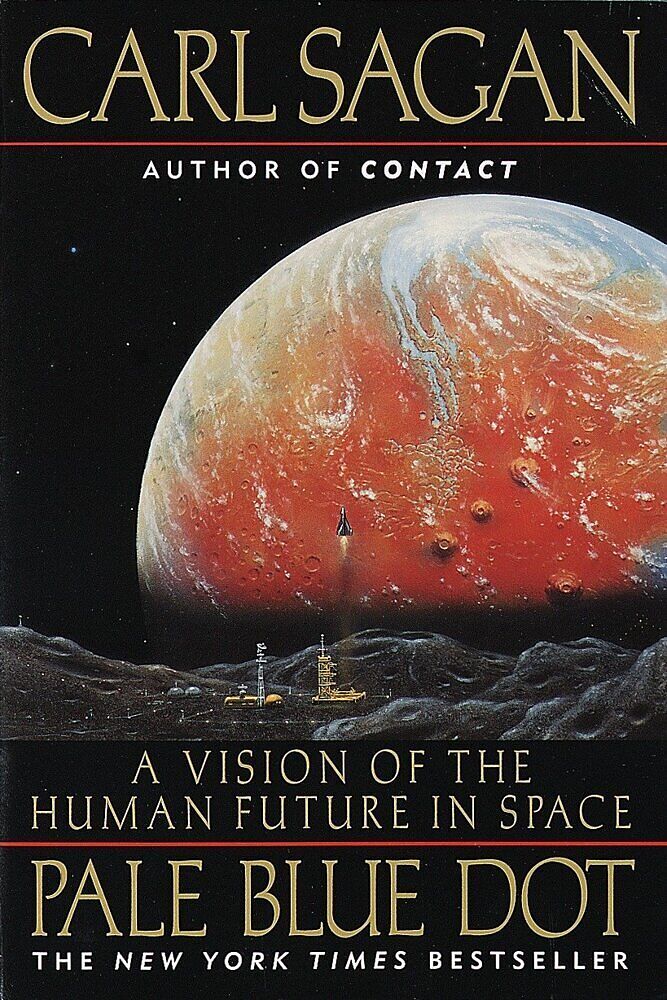Pale Blue Dot
Einband:
Kartonierter Einband
EAN:
9780345376596
Untertitel:
A Vision of the Human Future in Space
Genre:
Natur & Technik
Autor:
Carl Sagan, Ann Druyan
Herausgeber:
Random House N.Y.
Anzahl Seiten:
384
Erscheinungsdatum:
08.09.1997
ISBN:
978-0-345-37659-6
Informationen zum Autor Carl Sagan served as the David Duncan Professor of Astronomy and Space Sciences and Director of the Laboratory for Planetary Studies at Cornell University. He played a leading role in the Mariner, Viking, Voyager, and Galileo spacecraft expeditions, for which he received the NASA Medals for Exceptional Scientific Achievement and (twice) for Distinguished Public Service. His Emmy- and Peabodywinning television series, Cosmos, became the most widely watched series in the history of American public television. The accompanying book, also called Cosmos, is one of the bestselling science books ever published in the English language. Dr. Sagan received the Pulitzer Prize, the Oersted Medal, and many other awardsincluding twenty honorary degrees from American colleges and universitiesfor his contributions to science, literature, education, and the preservation of the environment. In their posthumous award to Dr. Sagan of their highest honor, the National Science Foundation declared that his research transformed planetary science . . . his gifts to mankind were infinite." Dr. Sagan died on December 20, 1996. Klappentext "Fascinating . . . memorable . . . revealing . . . perhaps the best of Carl Sagan's books."-The Washington Post Book World (front page review) In Cosmos, the late astronomer Carl Sagan cast his gaze over the magnificent mystery of the Universe and made it accessible to millions of people around the world. Now in this stunning sequel, Carl Sagan completes his revolutionary journey through space and time. Future generations will look back on our epoch as the time when the human race finally broke into a radically new frontier-space. In Pale Blue Dot, Sagan traces the spellbinding history of our launch into the cosmos and assesses the future that looms before us as we move out into our own solar system and on to distant galaxies beyond. The exploration and eventual settlement of other worlds is neither a fantasy nor luxury, insists Sagan, but rather a necessary condition for the survival of the human race. "Takes readers far beyond Cosmos . . . Sagan sees humanity's future in the stars."-Chicago Tribune Zusammenfassung Fascinating . . . memorable . . . revealing . . . perhaps the best of Carl Sagan's books. The Washington Post Book World (front page review) In Cosmos ! the late astronomer Carl Sagan cast his gaze over the magnificent mystery of the Universe and made it accessible to millions of people around the world. Now in this stunning sequel! Carl Sagan completes his revolutionary journey through space and time. Future generations will look back on our epoch as the time when the human race finally broke into a radically new frontierspace. In Pale Blue Dot! Sagan traces the spellbinding history of our launch into the cosmos and assesses the future that looms before us as we move out into our own solar system and on to distant galaxies beyond. The exploration and eventual settlement of other worlds is neither a fantasy nor luxury! insists Sagan! but rather a necessary condition for the survival of the human race. Takes readers far beyond Cosmos . . . Sagan sees humanity's future in the stars. Chicago Tribune ...
Klappentext
"Fascinating . . . memorable . . . revealing . . . perhaps the best of Carl Sagan's books."-The Washington Post Book World (front page review)
In Cosmos, the late astronomer Carl Sagan cast his gaze over the magnificent mystery of the Universe and made it accessible to millions of people around the world. Now in this stunning sequel, Carl Sagan completes his revolutionary journey through space and time.
Future generations will look back on our epoch as the time when the human race finally broke into a radically new frontier-space. In Pale Blue Dot, Sagan traces the spellbinding history of our launch into the cosmos and assesses the future that looms before us as we move out into our own solar system and on to distant galaxies beyond. The exploration and eventual settlement of other worlds is neither a fantasy nor luxury, insists Sagan, but rather a necessary condition for the survival of the human race.
"Takes readers far beyond Cosmos . . . Sagan sees humanity's future in the stars."-Chicago Tribune
Leseprobe
1
The spacecraft was a long way from home, beyond the orbit of the outermost planet and high above the ecliptic plane—which is an imaginary flat surface that we can think of as something like a racetrack in which the orbits of the planets are mainly confined. The ship was speeding away from the Sun at 40,000 miles per hour. But in early February of 1990, it was overtaken by an urgent message from Earth.
Obediently, it turned its cameras back toward the now-distant planets. Slewing its scan platform from one spot in the sky to another, it snapped 60 pictures and stored them in digital form on its tape recorder. Then, slowly, in March, April, and May, it radioed the data back to Earth. Each image was composed of 640,000 individual picture elements (“pixels”), like the dots in a newspaper wirephoto or a pointillist painting. The spacecraft was 3.7 billion miles away from Earth, so far away that it took each pixel 5½ hours, traveling at the speed of light, to reach us. The pictures might have been returned earlier, but the big radio telescopes in California, Spain, and Australia that receive these whispers from the edge of the Solar System had responsibilities to other ships that ply the sea of space—among them, Magellan, bound for Venus, and Galileo on its tortuous passage to Jupiter.
Voyager 1 was so high above the ecliptic plane because, in 1981, it had made a close pass by Titan, the giant moon of Saturn. Its sister ship, Voyager 2, was dispatched on a different trajectory, within the ecliptic plane, and so she was able to perform her celebrated explorations of Uranus and Neptune. The two Voyager robots have explored four planets and nearly sixty moons. They are triumphs of human engineering and one of the glories of the American space program. They will be in the history books when much else about our time is forgotten.
The Voyagers were guaranteed to work only until the Saturn encounter. I thought it might be a good idea, just after Saturn, to have them take one last glance homeward. From Saturn, I knew, the Earth would appear too small for Voyager to make out any detail. Our planet would be just a point of light, a lonely pixel, hardly distinguishable from the many other points of light Voyager could see, nearby planets and far-off suns. But precisely because of the obscurity of our world thus revealed, such a picture might be worth having.
Mariners had painstakingly mapped the coastlines of the continents. Geographers had translated these findings into charts and globes. Photographs of tiny patches of the Earth had been obtained first by balloons and aircraft, then by rockets in brief ballistic flight, and at last by orbiting spacecraft—giving a perspective like the one you achieve by positioning your eyeball about an inch above a large globe. While almost everyone is taught that the Earth is a sphere with all of us somehow glued to it by gravity, the reality of our circumstance did not really begin to sink in until the famous frame-filling Apollo photograph of the whole Earth—the one taken by the Apollo 17 astronauts on the last journey of humans to the Moon.
It has become a kind of icon of our age. There’s Antarctica at what Americans and Europeans so readily regard as the bottom, and then all of Africa stretching up above it: You can see Ethiopia, Tanzania, and Kenya, where the earliest humans lived. At top right are Saudi Arabia and what Europeans call the Near East. Just barely peeking out at the top is the Mediterranean Sea, around which so much of our global civilization emer…

Leider konnten wir für diesen Artikel keine Preise ermitteln ...
billigbuch.ch sucht jetzt für Sie die besten Angebote ...
Die aktuellen Verkaufspreise von 6 Onlineshops werden in Realtime abgefragt.
Sie können das gewünschte Produkt anschliessend direkt beim Anbieter Ihrer Wahl bestellen.
Loading...
Die aktuellen Verkaufspreise von 6 Onlineshops werden in Realtime abgefragt.
Sie können das gewünschte Produkt anschliessend direkt beim Anbieter Ihrer Wahl bestellen.
| # | Onlineshop | Preis CHF | Versand CHF | Total CHF | ||
|---|---|---|---|---|---|---|
| 1 | Seller | 0.00 | 0.00 | 0.00 |
